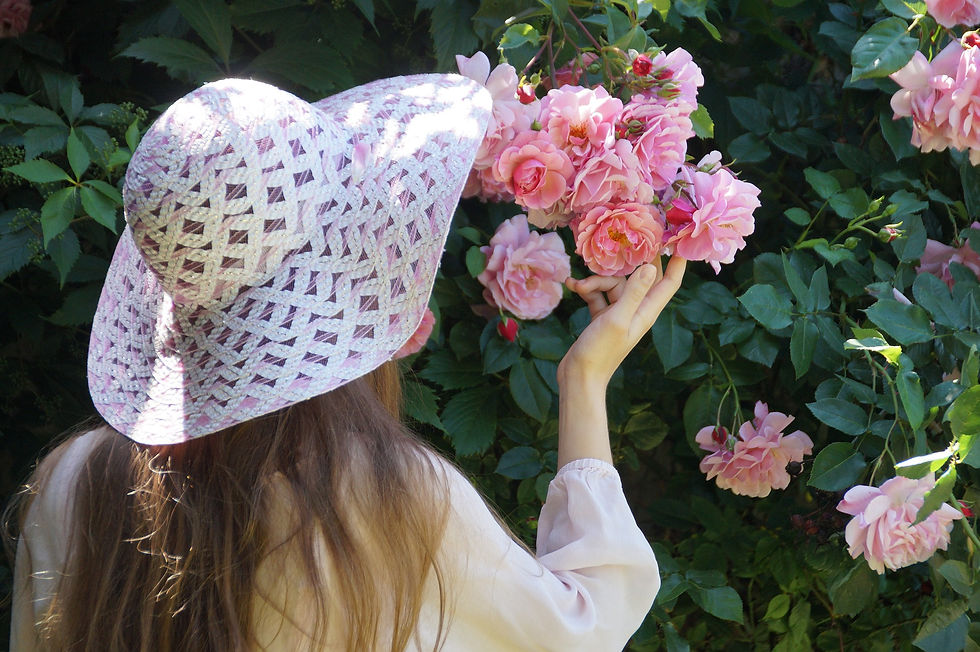Discover the Hope Rose and a Wondrous Old Rose Garden
- Linda Borromeo

- Jun 8, 2023
- 4 min read
Updated: Aug 11

My husband and I looked down at our sad miniature rose. "I don't think it's going to make it," Peter said.
When Peter gave me the little rose bush for Valentine's Day, it boasted a wealth of tiny red blossoms. Now we knew the rose was in trouble. It struggled to thrive on our Berkeley apartment's shaded deck.
In an attempt to find more sun, we moved the plant container several times, Nothing helped, and it was discouraging to see more leaves turn yellow and drop off every day.
Just when the rose looked its worst, Peter and I had the opportunity to move to a cottage in Modesto—the first home of our own. Of course, we kept to the motto, "No living thing left behind." Our small band of travelers included Babbitt (my miniature white rabbit with delicate gray ears and paws), a playful yellow parakeet, an imperious blue parakeet—and the rose.
At our new home, we planted the rose in a place with abundant sunshine. Every sign pointed to the possibility we were too late, but we wanted to give it a chance.
To our delight, the floundering rose took hold. It gained momentum each year until it grew tall and lush. The blossoms rejected any ideas about being miniature. In the summer, the buds opened into great swirls of crimson petals. The leaves—green and healthy—stayed put.
We called it the "Hope Rose," and it encouraged us during those inevitable times when things were difficult.
A Wondrous Old Rose Garden
I've been thinking about our Hope Rose as I've become immersed in a lovely place of old roses. They grew on the cosmopolitan Wooded Island, a part of the 1893 Chicago World's Fair.
In the book I'm closing in on finishing, Mystery Fair, the Wooded Island is the center of secrets at the Chicago World's Fair. Christie and Melina must investigate a dangerous mystery— what happened to Melina's vanished father?

In Norman Bolotin and Christine Laing's intriguing book, I learned that more than 27 million visitors arrived at the Chicago World's Fair between May and October 1893. There were 214 fanciful buildings to explore on 633 acres. However, the noise, hurry, and overwhelming choices of exhibits left fairgoers longing for a break.
The Wooded Island was designed as a much-needed retreat. The island provided a green haven with its peaceful winding paths, a variety of sheltering trees, and a delightful bouquet of living flowers. The Wooded Island spanned sixteen charming acres, with ten acres planted in flowers.

After crossing the graceful bridge spanning a lagoon, weary fairgoers first noticed the scent of thousands of roses wafting their way. Countries from all over the world sent their best roses to Chicago. As visitors strolled along the rose garden paths, the wealth of blossoms were dazzling.
Rose Garden Discoveries
But which rose varieties dazzled them? I thought it would be easy to find the names of the rose varieties in the garden. I was wrong. I enjoy going down the rabbit trails (or should I say, Babbitt trails) of history, but none of them led me to any of the lovely old rose names.

Then, tucked away in a 1894 Report issued by the state of New York, I found a listing of some of the roses on display on the fairgrounds and the Wooded Island. Here I discovered the beautiful names of vintage roses—Perle des Jardins, Souvenir de la Malmaison, Comtesse de Labarthe, Etoile de Lyon, and the Grace Darling rose.
In a Garden
Roses engage every sense—the smooth velvet of the rose petals, the different shapes and colors of each blossom, and the lovely scent of romantic roses from ancient varieties.

When guests finally emerged from the Wooded Island's rose garden, I wonder if they sat down on one of the rustic benches to let it all sink in before heading out to view the next exhibit.
It must have been a magical place. I like to think my Hope Rose would have fit right in with all the beautiful, world-traveling roses on display in the island garden. And I hope, in between solving a dangerous mystery, Christie and Melina might take a break themselves in the wondrous old rose garden.
Sources:
Bolotin, Norm and Christine Laing. The World’s Columbian Exposition : The Chicago World’s Fair of 1893. University Of Illinois Press, 2002.
Report of the Board of General Managers of the Exhibit of the State of New York, at the World’s Columbian Exposition. 1894. Accessed via Internet Archives, 8 June 2024.
Join the adventure as Melina and Christie solve dangerous island secrets. Book Two in Linda's Islands of Mystery Trilogy was named a finalist in the Cascade Writing Contest. See more about Linda's books here >


